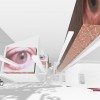Virtual Guggenheim
Artist: Asymtote, United States,
When speaking of an architecture for the next millennium there are two conditions to consider. Primarily the physical space of architecture as we have always known it, enclosure, form and permanence will without doubt persevere and another virtual architecture surfacing now in the digital domain of the Internet. Buildings, institutions, objects and space are now being constructed, navigated, experienced, comprehended and altered in their virtual states by countless people across the globe. This is a new architecture of liquidity, flux and mutability predicated on technological advances and fueled by a basic human need to probe the unknown. The path that both these architectures, the real and the virtual, will inevitably take will be one of convergence and merging. Historically, architecture has always struggled with this dialectic of the real and the virtual at once, architecture’s stability and actuality has always been tempered by the metaphysical and the poetic.
from The Museum as a Digital Experience, Hani Rashid
Editor's Critique
My first impression of the Virtual Guggenheim was less than stellar. Its morphing architecture seemed more a rebellion against the static nature of physical architecture than an expression of true virtual design. Never built, it was hard to imagine more. Yet as my own efforts in virtual art gallery design grew, my appreciation of the potential of this design grew as well. Gallery spaces flow like blood vessels through the arteries of the structure. This breaking of space into mobile rooms allows for vast changes in scale between rooms and multiple curatorial relationships as the ordering of rooms can easily changed by the curator or by the individual visitor's own search priorities. Moreover the addition or removal of rooms is an easy matter (in theory).
Lastly, the interface they tried to create in the distance - an overlay of text upon the structure is revealing. The morphing nature of the core structure makes it difficult to envision as doable - but if static, perhaps there is potential. My own thoughts had considered space, distance, and interface in a sense that a main street could when viewed far away could act like a main menu.
- Genre: Yes, VRML / X3D, Museums - Galleries, Abstract, PC
- Year: 2000
- Websites: http://www.asymptote.net/, http://openbuildings.com/buildings/guggenheim-virtual-museum-profile-2437





